In discussing plumbing with a plumber, builder, or inspector – knowing the different types of pipes used in your home can make you a more informed consumer. The water that arrives and leaves your home may travel through as many as five different types of pipes on its journey, and each has a specific use along the way. Building codes in most municipalities govern which materials are to be used for each function.
PEX (polyethylene cross linked pipe) is an inexpensive plastic tubing used commonly for water supply lines. It is both inexpensive and safe. The material is inexpensive and it is flexible, which makes it easy to install and saves money on labor. It can be used with a variety of connection methods which adds to its ease of use. It also comes in color coding to make it easier to track lines for hot and cold water lines. These lines are most often run directly from a water distribution source to a faucet. Since there is no metal in this type of pipe there is no danger of contamination of the water passing through it.
PVC (polyvinyl chloride pipe) is used for wastewater disposal, particularly home sewage systems. It is ideal for low pressure and low temperature water transport as is found in sewage disposal, sink drains, and plumbing vents. It comes in large diameters to move larger volumes of water. PVC is not to be used for high pressure lines or hot water.
ABS (acrylonitrile butadiene styrene) is used for most of the same purposes as PVC pipe, and it has many of the same properties. It is recognizable by its stark black color. It enjoys an advantage over PCV in that it is more durable. It reacts to sunlight and cannot be used anywhere it will be exposed to direct light.
Copper is the most reliable of water lines as it is more resistant to damage than PEX, and it is well regarded since copper does not react to water and ensures no adverse impact on water passing through it. While it provides high quality water transmission, copper is expensive material, and requires professional installation to ensure safe, effective joints created by the high heat of a propane torch. Its high cost of purchase and expensive installation offers many years of trouble free operation.
Galvanized pipe was a replacement for lead pipes in older homes and offered safer drinking water. However, their tendency to rust posed a risk to the quality of drinking water. Replacing them with low cost, easy to install PEX lines or highly reliable but more expensive copper lines is a sound investment in quality drinking water.
Knowing the materials which move water into, through and away from your home can make you a more informed consumer in construction, repair and upgrades in your home.


